How to Know What Size Flange You Need
Finding The Right Breast Pump Flange Size
Finding the right fit is always important – whether it'due south for wear, shoes, only especially when information technology comes to your chest pump flange size if you lot're a breast pumping mom. Soreness, pinching, irritation, and clogged milk ducts don't audio fun only are all things that tin occur if you don't have the correct flange size. A breast pump flange (breast shield) size that is too minor or also large could seriously hinder your pumping experience and overall breast pumping journey. Then, exist certain to cull the right size to properly express milk for your infant.
A common question that many don't know is related to flange sizing is: How can we all-time ensure maximum milk output while pumping? The respond is making the pumping session both comfortable and efficiently stimulating the breasts. To achieve this, flange sizing is incredibly important when planning to utilize a breast pump. The flange mimics and simulates what a proper and comfortable latch feels and looks like from a baby's latch. Too large, and the areola gets compressed, causing the milk to get stopped prior to release, much similar a water hose kink. Besides small, and the nipple receives likewise much friction, causing blisters, soreness, and inadequate stimulation.
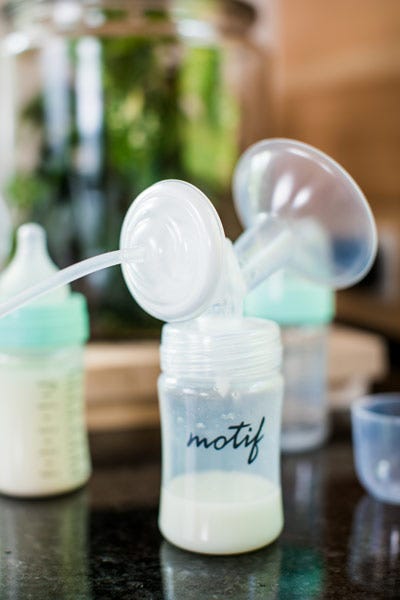 It may seem overwhelming, 1 more thing to learn, especially for a new mom. Permit's take a closer look at the mechanics sizing to better understand and ready for your perfect size!
It may seem overwhelming, 1 more thing to learn, especially for a new mom. Permit's take a closer look at the mechanics sizing to better understand and ready for your perfect size!
First, What Is A Breast Pump Flange?
A chest pump flange is the funnel or cone-shaped plastic cup that fits directly over your nipple to form a seal effectually the areola to create a vacuum that gently draws the nipple into the funnel for milk extraction.
Not having the correct flange size could impact your milk period by causing impairment to the breast tissue, blocked milk ducts, hurting, nipple impairment, swelling, or cuts on the nipple. Only with finding the right flange, you can comfortably maximize milk production.
Understanding the Fit of the Chest Pump Flange
When considering the nipple, pay close attention to how the nipple sits in the narrow tunnel of the flange. A proper fit has the nipple centered, without any rubbing on the walls. This allows the nipple to move freely and stretch.Quite similar to feeding directly: Since it's referred to as "breastfeeding" and non "nipple feeding," the nipple is not the but function of the breast to receive attending. The narrow end of the flange should allow a subtle amount of areolar tissue at the base of the nipple. Too large a size, and the areola gets pinched or kinked, preventing the release of milk, and may fifty-fifty accrue blisters.The areola (uh-REE-oh-la) is the darkened surface area around the nipple. Lubricating pores, referred to as the Montgomery glands, are often more prominent during lactation, and are located on the areola. The primary functions of the areola is to serve an easy-to-see bullseye for the infant to aim for when latching, only as well a collective where all of the milk ducts / channels send the milk from storage.When sizing a flange, the areola should not exist ignored. The funnel, or breast shield, of the flange mimics the lips of a baby. If none of the areola makes information technology into the oral cavity or the flange, at that place is inadequate stimulation to the breast, that may interfere with long-term supply and milk production. It may also affect comfort, every bit this could also mean tightness around the nipple, which has a negative touch on milk production, likewise. 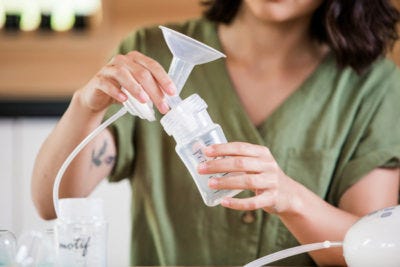 A comfortable fit for both means less physical stress on the breasts, which helps the body relax and respond well to oxytocin, the hormone responsible for releasing milk that is produced and stored.
A comfortable fit for both means less physical stress on the breasts, which helps the body relax and respond well to oxytocin, the hormone responsible for releasing milk that is produced and stored.
Finding The Right Breast Pump Flange Size
Motif'south goal is to assistance mom have the most comfortable pumping journey possible. Our handy flange sizing chart helps you determine your best fit. Exist sure to review each size option to choose the one that will fit best. 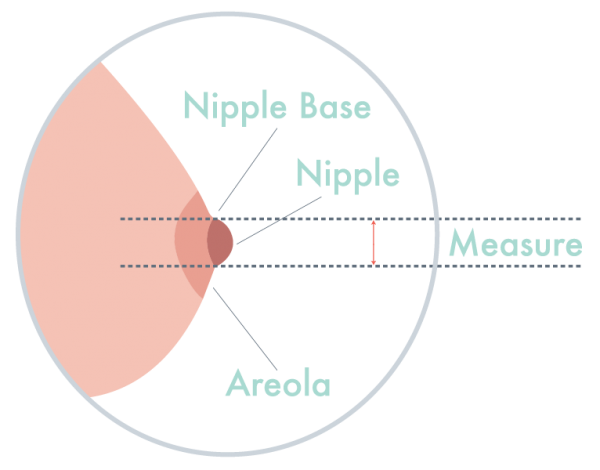
Flanges are sized in millimeters (mm). It should be slightly larger than the nipple measurement to allow for move. Its likewise important to measure BOTH nipples, as only similar in chest size, symmetry is not always part of the equation.
To decide what size you need, you'll need to know your nipple size. Yous can measure your nipple past taking a ruler or measuring tape to measure the bore of your nipple (the horizontal width across it). Measure out the nipple lone, do non include the areola which is the outer edge effectually your nipple.
The measurement should be in millimeters (1 cm = 10mm)
Then select your flange size based on your measurement.
- If you measured up to 17mm you'll fit in a 21mm flange.
- If y'all measure upwardly to 22mm apply size 24mm.
- If you measured up to 23mm select size 27mm.
- If you measured up to 26mm use 30mm.
- If y'all measured upwards to 32 mm apply size 36 mm.
A quick trick for a starting place is to make the ASL sign for "I love you," and compare the fingers for approximate nipple size comparison. The thumb 24-26 mm, the index 21-23mm, and the pinky 20 or smaller. Sizes needed would be 30, 27, and 24, respectively.
Once a size estimate is completed, gently pumping and observing the fit and move will ensure the correct fit has been accomplished.
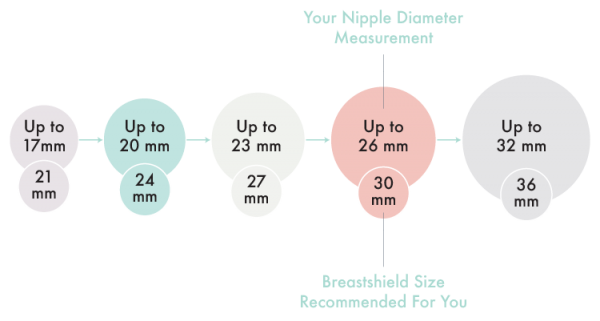
Y'all'll know if y'all have the right pump shield if:
- Your nipple is in the center of the flange and moves freely into the tunnel of the breast pump for comfortable milk expression.
- Your areola has petty to no tissues inside the tunnel of the breast pump.
- Yous do not feel areas of the chest that notwithstanding comprise milk, as this could signal uneven breast milk extraction.
- You don't feel any nipple hurting.
- Your nipple and areola do not turn white or become discolored, significant the blood supply has non been cut off.
Ashley Georgakopoulos, Motif Medical Lactation Director (IBCLC), explained that when looking for the correct fit to, "Find what is comfortable. As well much friction to the tissue, tightness, or painful sucking could indicate the incorrect size. The top of the nipple and its base of operations should be the only part entering the flange tunnel."
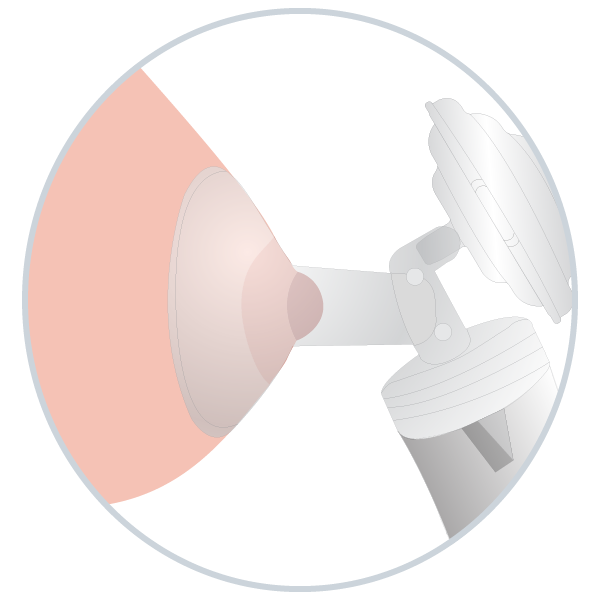
How To Tell If Your Flange Is Too Small
If your breast pump flange is too small you may feel:
- Rubbing as the nipple is pulled against the sides of the breast pump tunnel.
- Pinching and squeezing of the nipple.
- Your nipple or areola becomes white or discolored.
- Low breast milk production.
- Painful milk extraction.

How To Tell If Your Flange Is Too Big
If your chest pump flange is besides big you lot may experience:
- Your areola could become pulled into the flange and tunnel
- Painful nipple pinching, pulling, and squeezing
- Lower breast milk production
- Your nipple or areola could become white or discolored

When to Size
Throughout pregnancy the breast tissue can be seen going through changes. This includes the size of the breast, every bit well as the darkening of the areola. Another modify would be the size of the nipples. While, for some, the change is subtle, it can still impact the initial fit of the flange. Women tend to retain fluid as the pregnancy progresses, as well as when fluids are administered. The early part of the third trimester or 2-3 weeks postpartum is a groovy fourth dimension frame to measure the nipple to get a good idea of what size the nipple will be for the majority of the times needed for pumping. A separate measurement may exist needed if pumping and expressing milk is needed immediately postpartum or there are any noticeable changes in size.
Bonus Flange Size Tips
- If this is your get-go-time chest pumping, consult with a lactation consultant to assist with determining the flange fit according to nipple shape, areola density, and areola fullness.
- Mensurate both of your nipples in example they are different sizes. Some moms need 2 unlike flange sizes.
- Your flange size could change over time, specially later giving birth. Regularly measure your nipples to run into if you need to change sizes or non.
 Whether a new mom or a veteran, anyone tin need assistance with pumping. An Internationally Lath Certified Lactation Consultant (IBCLC) volition have all-encompassing training in helping with finding the perfect size flange, along with pumping techniques, storage, feedings, troubleshooting and more!
Whether a new mom or a veteran, anyone tin need assistance with pumping. An Internationally Lath Certified Lactation Consultant (IBCLC) volition have all-encompassing training in helping with finding the perfect size flange, along with pumping techniques, storage, feedings, troubleshooting and more!
Source: https://motifmedical.com/blog/why-the-best-breast-pump-flange-size-is-important
0 Response to "How to Know What Size Flange You Need"
Post a Comment